Texas Railroad History - Tower 38 - Galveston
A Crossing of the Galveston, Harrisburg & San Antonio;
Galveston, Houston & Henderson; and Gulf, Colorado & Santa Fe railroads
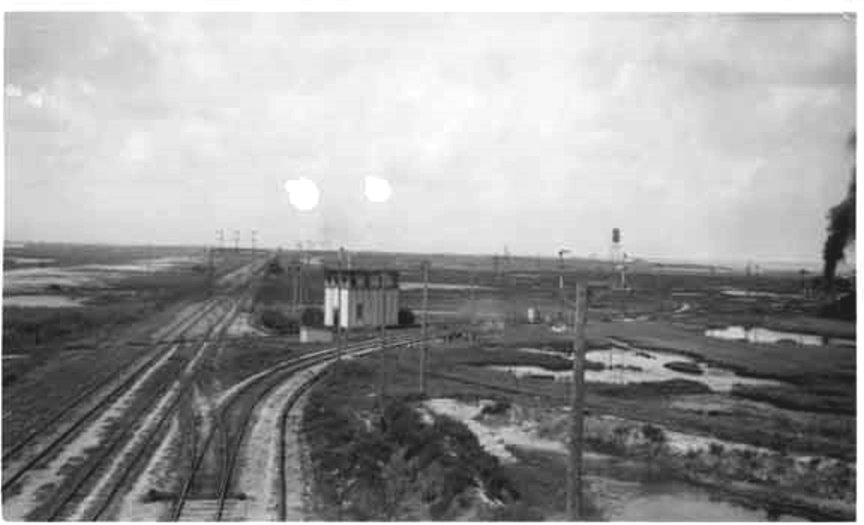
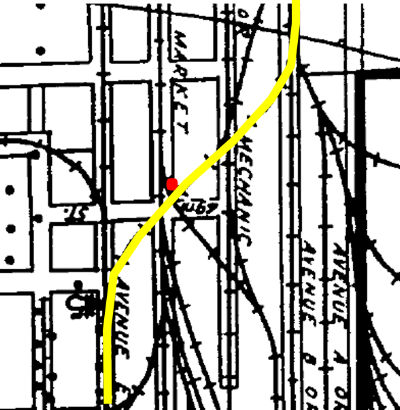
Above Left:
This image from
Russell Crump's
Santa Fe Railway Archive is a 1921 view of Tower 38 with the photographer facing west-southwest
away from downtown Galveston. The Galveston, Houston & Henderson (GH&H)
Railroad main tracks
to the left of the tower extend to the horizon, and the "Z-track" of the Galveston,
Harrisburg & San Antonio Railway crosses in front of, and parallel to, the
long side of the tower. In the foreground, a connecting track off the GH&H is
visible curving to the right and merging onto the Z-track. Another track comes
in at an angle from the right, crosses the connecting track and the Z-track, and
then passes beside the short side of the tower to join the main track. The tower
shows three large windows on the long side and two on the short side. A lower
story window is visible on the long side and a door is present on the short
side. The tower appears to have a flat roof, an unusual characteristic compared
to other manned interlocking towers in Texas.
Above Right:
This snippet taken from the index of the
1912 Sanborn Fire Insurance map set of Galveston highlights the "Z-track"
(yellow) crossing
left-to-right diagonally northwest from Ave. E to Ave. B. Like the photo, the
orientation has west-southwest "up", away from downtown Galveston.
Below: This snippet from a
1933 map (with North "up") conveys the labyrinth of rail lines and spurs serving
the docks, wharves and piers that evolved in Galveston over many decades. For a
perspective on where Tower 38 sat, the Z-track is
highlighted in red. From this angle, the tower was to the left of the Z-track on
the north side of the GH&H tracks. The Galveston
Island Causeway across Galveston Bay is just off the map to the left.

For decades before (and for many years
after) the Houston Ship Channel opened in 1914, Galveston was the major
port for Texas and the southwestern U.S. It
is not surprising that railroads crisscrossed Galveston Island to provide land connections for ocean
freight. One important Texas railroad, the Gulf, Colorado & Santa
Fe (GC&SF) Railway, was founded in Galveston, while two other major lines,
the Galveston, Harrisburg & San Antonio (GH&SA) and the Galveston, Houston &
Henderson (GH&H), were active on the island. All three railroads eventually had roundhouses there.
The island was initially reached from the mainland by trestles across Galveston
Bay. In the aftermath
of the Great Hurricane of 1900
(the deadliest natural disaster in U.S. history) which practically wiped out the island and
destroyed two of the three trestles, the
Galveston Island Causeway was constructed to carry
vehicular traffic, steam railroads and electric interurban lines over Galveston
Bay. Although the hurricane caused outside investors to begin focusing on
Houston farther inland, Galveston recovered to restore its track and port
infrastructure and resume its position as one of the busiest ports in the U.S.
Over the decades since then, Galveston's cargo tonnage has declined in
relative terms as it lost ground to Texas ports at Houston,
Texas City, Beaumont, Port Arthur,
Corpus Christi and Freeport (but Galveston is the fourth busiest homeport in the
U.S. for cruise ship passengers, and the largest outside of Florida.)
Galveston's rail infrastructure has
been pared down and optimized by the two major railroads that continue to serve
the island: Union Pacific (UP) and Burlington Northern Santa Fe (BNSF).
In 1901, less than a
year after the hurricane, a new state law took effect commanding the Railroad
Commission of Texas (RCT) to begin regulating railroad crossing safety. To
prevent collisions, state law already required all trains to stop completely
before crossing the tracks of another railroad at grade. In addition to creating
delays, the loss of physical momentum caused by these stops increased fuel and
water requirements for locomotives as they reaccelerated to track speed beyond
the crossings. The stops were wasteful of time and fuel since the vast majority
of the time, a train approaching a crossing would find it unoccupied. The new
law was focused primarily on the implementation of safety systems that could
eliminate the need for trains to stop, saving time, water and fuel. The state of
the art in railroad grade crossing safety was interlocker technology developed
and deployed elsewhere in the U.S. Interlockers used a combination of home signals, distant signals and derails
governed by electro-mechanical devices to control how trains
approached and crossed other railroads at grade. As permitted by Texas law, RCT began
issuing orders periodically to require railroads to install interlocking plants
at specific crossings, with each installation to be inspected and approved by
RCT before operations commenced.
 |
Left: As the
rail infrastructure at Galveston was being rebuilt in the aftermath of
the storm, RCT ordered three railroads to interlock their crossings at
the "z" tracks. This image is from a list of the crossing
orders issued by RCT and printed in its 1903 Annual Report. Note that
the numbers do not correspond to the eventual tower numbers. |
One of the Z-track railroads listed by RCT was the
Galveston, Houston & Northern (GH&N). Understanding its origins requires
background on the development of rail access to Galveston. After the GH&H (in
1860) and the GC&SF (in 1875) completed their trestles over Galveston Bay, there
was a period of twenty years in which no additional bridges were built. Using
trackage rights agreements and leases, other railroads were able to obtain
access to Galveston over the two bridges. At
various times, the GC&SF ("Santa Fe") allowed other railroads to use its bridge
when it perceived a strategic advantage. The principal beneficiary of these
arrangements was B. F. Yoakum, a former Santa Fe executive who had moved on to
become the General Manager of the St. Louis and San Francisco ("Frisco") Railway
in the latter 1890s, subsequently becoming Frisco's President. Yoakum convinced Santa Fe to partner with him in chartering
the Houston Belt & Terminal Railway in 1904, but the final Yoakum - Santa Fe
deal came in 1908 when Denver - Galveston single-train service commenced.
Yoakum's Trinity & Brazos Valley (T&BV) Railroad carried the southern leg of the
journey between Fort Worth and Galveston, using
trackage rights on Santa Fe rails between Houston
and Galveston.
The GH&H, having suffered through the physical and
financial damage of the Civil War, went through a lengthy reorganization and
then was reorganized again after being acquired by rail baron Jay Gould in 1882.
Under Gould control, the GH&H eventually became the province of two Gould
properties: the International & Great Northern (I&GN) and the Missouri, Kansas &
Texas ("Katy") railroads. The Katy wriggled free of Gould control in 1891 and,
claiming to own the GH&H, sued to terminate the I&GN's trackage rights into
Galveston. After a lengthy court battle, the two railroads ended up with equal joint ownership
of the GH&H and unlimited rights to use its line to Galveston.
While the two Gould railroads battled over the GH&H, a third railroad, Southern Pacific (SP),
had also been granted GH&H bridge access by Gould. This came about when Gould
was furiously building his Texas & Pacific (T&P) line west from Fort Worth in
1881, trying to reach El Paso before SP got there. Gould soon realized he had no
chance; SP President C. P. Huntington had struck a deal with GH&SA President
Thomas Peirce to finance GH&SA construction between El Paso and
San Antonio.
While SP was still working to complete its
line from California across Arizona and New Mexico, Huntington would field a
construction team to build east from El Paso under the GH&SA charter while
Peirce's team built west from San Antonio (and when the line was finished, SP
leased, and then acquired, the GH&SA.) There were prospects for a deal; Gould wanted access to El
Paso and Huntington wanted the existing rights and franchises the T&P had
obtained in Arizona and New Mexico when it had begun planning its
Federal-chartered southern transcontinental line between
Texarkana and San
Diego. As part of a comprehensive agreement that included traffic arrangements
and sharing
SP's tracks between El Paso and the tiny west Texas junction of Sierra Blanca,
Gould had also granted SP trackage rights on the GH&H into Galveston. For
several years during the late 1880s, SP exercised its GH&H rights into Galveston, but it did not pursue extensive development on
the island. Huntington knew that to invest in serious infrastructure at
Galveston, SP would need its own bridge onto the island; his strategy was to let
someone else build it for him.
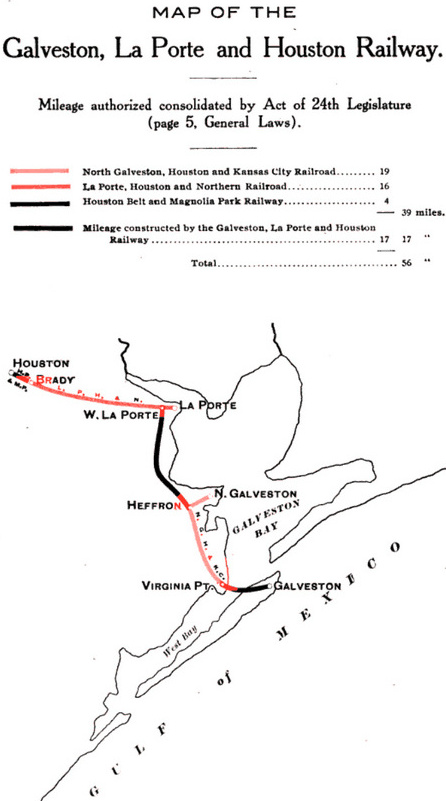 |
Left: from the book
Railroad Consolidations in Texas 1891 - 1903
by Joseph Draper Sayers, published in 1903
In the early
1890s, several small railroads began building lines to serve the coastal
area southeast of Houston. One of these was the La Porte, Houston and
Northern (LH&N) which was chartered in 1892 to build between La Porte
and Houston. Another was the North Galveston, Houston and Kansas City
(NGH&KC) Railroad which built twelve miles from Virginia Point to North
Galveston (now San Leon) on the mainland along Galveston Bay. In early
1895, a charter revision changed the LH&N name to the Galveston, La
Porte and Houston (GL&H) Railway. It immediately acquired the NGH&KC to
be part of a proposed line between Kansas City and Galveston. The GL&H's planned bridge over Galveston Bay was
of obvious interest to
SP, but before the bridge was finished, the GL&H filed for receivership on
January 7, 1896. A
hearing was held on January 20, 1896, and three days later, the
court's Special Master reported that approximately $300,000 was needed
to make the GL&H a viable competitor for Houston - Galveston traffic.
The judge authorized the court-appointed Receiver to borrow money by selling Receiver Certificates
not to exceed $250,000. The Receiver hired L. J. Smith, a Kansas City
construction firm, to resume the work including completion of the
Galveston Bay bridge. But when the GL&H
again ran
out of capital and L. J. Smith was
not paid for his construction work, he filed with the Court to force the GL&H
into liquidation.
Extensive litigation followed as the judicial
system attempted to sort out the GL&H's finances. A ruling by the U.S.
Fifth Circuit Court of Appeals described (below: Federal
Reporter, 1900) the report of the Special
Master which had insisted that for the GL&H, building a bridge over Buffalo Bayou in Houston
and completing the Galveston Bay bridge
were both necessary for its...

"...Galveston with the tracks of the Galveston Wharf Company..."
was essential to having any business at all.
It is no surprise that the four railroads listed as "north of
Buffalo Bayou" in the Fifth Circuit's ruling were owned by SP.
In 1897, SP offered
to buy the GL&H from the Receiver. Railway
Review reported in its March 20, 1897 edition... "An offer
has been made, so it is reported, by Mr. C. P. Huntington for the
purchase of the Galveston, La Porte & Houston, and while nothing
definite concerning the matter is known, it is thought the offer will be
accepted. The price offered is said to be $1,000,000. This is taken to
be a confirmation of the promise made by the Southern Pacific some time
ago to make Galveston one of its principal gulf ports. The G. L. P. & H.
is 53 miles in length running from Brady Junction to Galveston."
For undetermined reasons, Huntington's proposed purchase of the GL&H was
not completed. |
On July 6, 1898, the GL&H was sold at auction for $400,000 to
George Holt, said to be an agent of Huntington (right,
top), but the auction result was set aside by the the presiding judge. The
contractor, L. J. Smith, had complained to the Court that
the price was too low, and that a new auction should be held at which he
could participate (as to why he was not represented at the first
auction, the answer is undetermined.) The judge set a new auction date for October 4, 1898,
but to everyone's surprise, George Holt elected
not to bid (right,
bottom left), supposedly because SP had decided not
to pursue the GL&H. When the auction took place, the only bidder present
was Denison attorney R. C. Foster representing L. J. Smith. Foster
submitted Smith's bid of $425,000 and won the auction. The sale still
needed the approval of the judge. A hearing was held on
October 27 at which U.S. District Judge Bryant approved the sale (right,
bottom right.)
Some
kind of deal was ultimately struck between Smith and C. P. Huntington wherein the Galveston, Houston & Northern (GH&N) was chartered
on March 30, 1899 (below)
to acquire the GL&H from Smith, the transaction being finalized on April
27, 1899. This was a roundabout way of obtaining a bridge over
Galveston Bay, but C. P. Huntington's use of intermediaries
shielded SP from potential liability exposure to the lawsuits pending against the
GL&H.
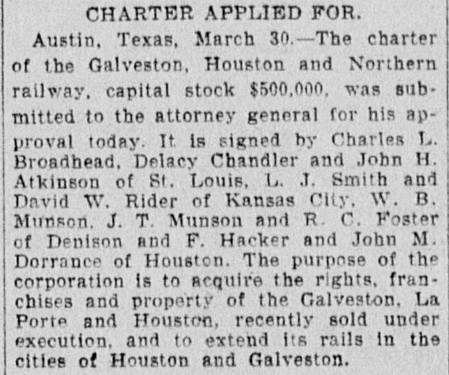 Left:
Houston Daily Post, March 31, 1899 Left:
Houston Daily Post, March 31, 1899
L. J. Smith was a founding director of the GH&N and he became
its Vice President. W. B. "Ben" Munson, founder of the town of Denison,
is also listed as a Director. The railroad was managed by executives of
the GH&SA and was effectively owned by SP. Unfortunately, the GH&N's Galveston Bay bridge
acquired from the GL&H was destroyed 18 months later in the
hurricane of 1900. |

The
Northwestern Railroader and Railway Age, Volume 26
(July-December 1898)
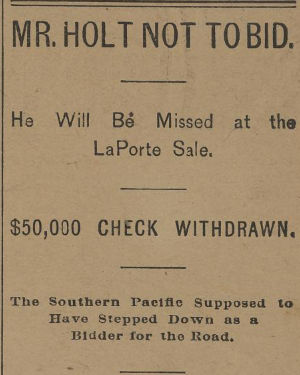
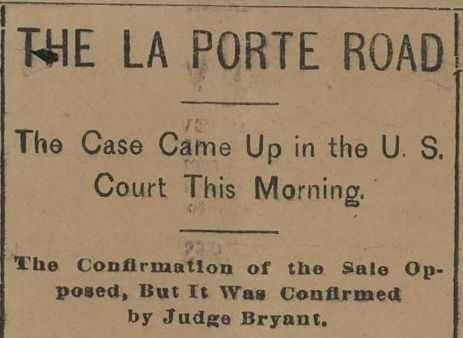
Above: the
Galveston Tribune, October 3 (left)
and October 27 (right), 1898 |
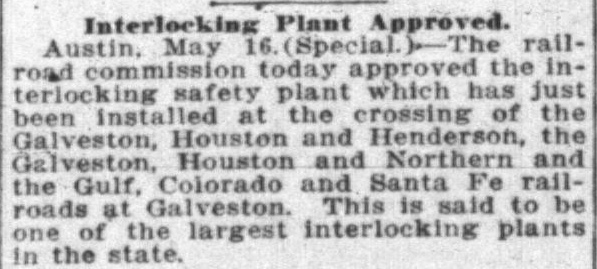 |
Left:
Fort Worth Record and Register, May
17, 1904
As the rail
infrastructure was rebuilt on Galveston Island in the storm's aftermath, RCT
commissioned
Tower 38 on May 16, 1904 with a Taylor Signal Co.
electrical interlocking plant supporting
66-functions spread over 44
active control levers. The three railroads listed by RCT as sharing the
operations and maintenance (O&M) expenses for the tower were the GH&H, the GC&SF
and the GH&N. The 66 functions made it the largest interlocking plant in Texas,
a pinnacle it lost two months later when Tower 42 began operating in Texarkana
with 70 functions. In 1905, SP was granted permission by the Legislature for
its GH&SA subsidiary to acquire and merge the GH&N. As of June 30, 1906,
Tower 38 reported that an average of 171 daily train movements had passed the tower
during the preceding twelve months. The last interlocker list published by RCT at
the end of 1930 reported Tower 38's interlocking plant having grown to 82 functions. |
In a list published October 31, 1916, RCT identified the GH&SA as the
railroad responsible for staffing the operations and maintenance (O&M) of Tower
38. The recurring O&M expenses would have been shared by the three railroads,
generally in proportion to the interlocker functions allocated to their tracks,
but the percentage splits for Tower 38 have not been found. The construction
date for the Z-track is undetermined, hence the allocation of capital expenses
for the tower and interlocking plant cannot be accurately projected. The Z-track
undoubtedly created the need for the tower, and if SP built the Z-track after
1901, SP would have paid all of the capital expenses to erect the tower. If the
Z-track existed in 1901 or earlier, the three railroads would have split the
capital expenses equally.
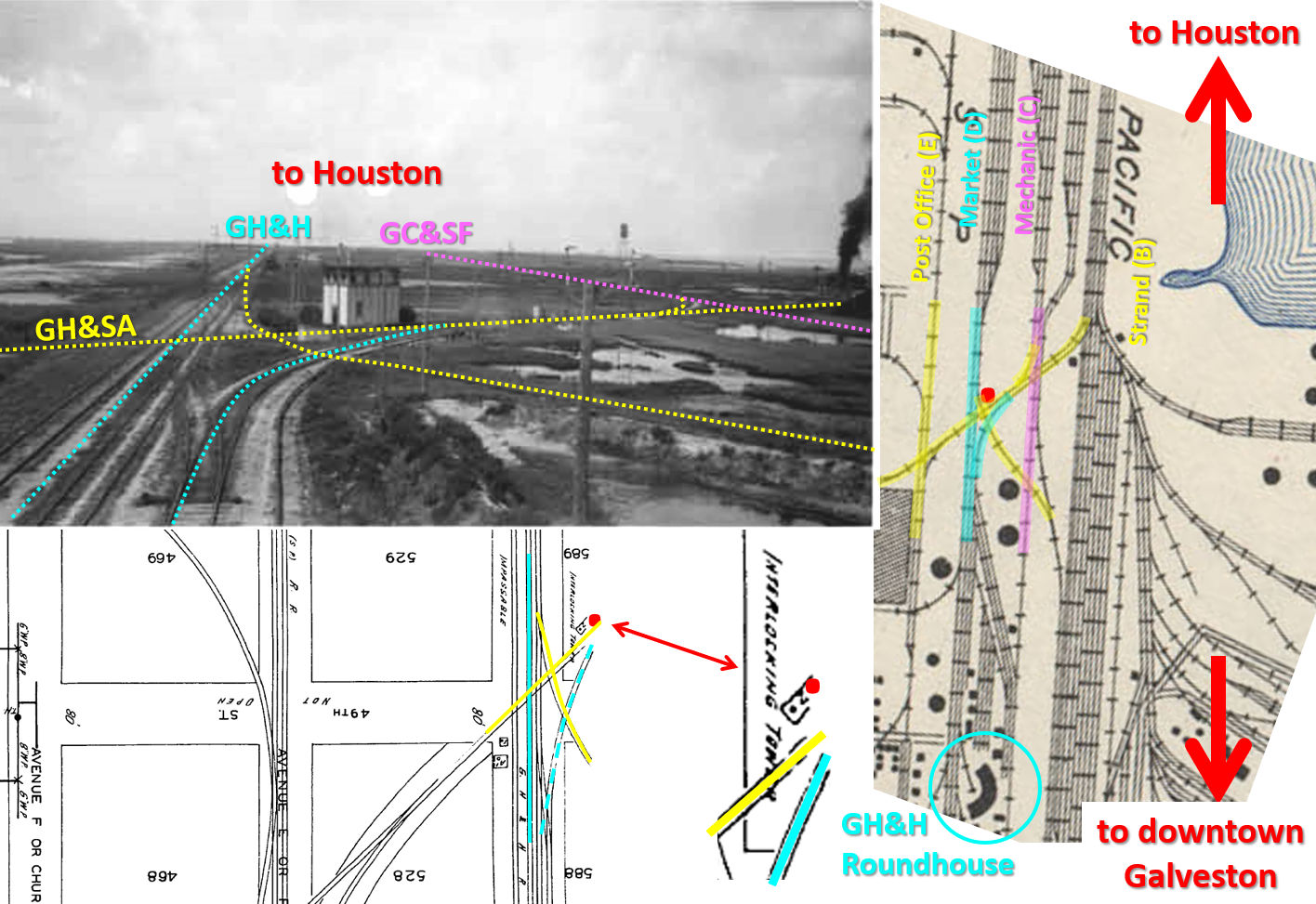
Above: Combining and
annotating the Tower 38 photo with snippets from the Sanborn Map of 1912 and a
1933 map of Galveston produces this fusion graphic to convey the track topology
near the tower. The maps have been reoriented to match the direction of the
photo, generally west, and they use a red dot to represent the tower. The color
scheme has yellow for the GH&SA, pink for the GC&SF, and light blue for the
GH&H. The tower was close to the intersection of Avenue D (Market St.) and 49th
Street; both streets were platted but neither were actually built in the
vicinity of the tower. Under magnification, the Sanborn Map shows the tower as
a rectangle with a dot on the lower end and the numeral '2' inside the
rectangle. This indicates a two-story structure with a door along the short wall
of the tower, both features being visible in the photo.
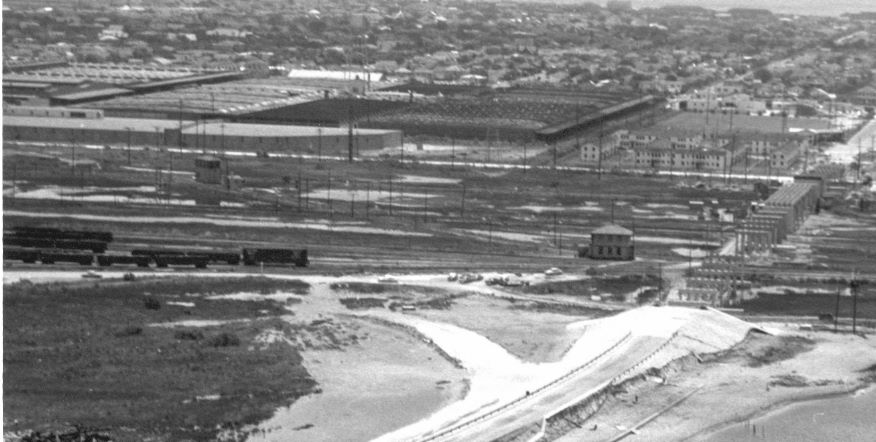 |
Left: This
snippet from a 1956 aerial photo faces southeast showing the 51st St. overpass under
construction on a south-southeast heading. The main lines running horizontally
across the image are generally west-southwest (right, toward the island
landing of the causeway) and east-northeast (left, toward downtown.)
Tower 38 is in the left center of the image with the Z track
crossing in
front of it parallel to the long side of the tower. The Z track continues across
the Santa Fe tracks into the
foreground to connect with the SP main line near the
SP yard office, the two-story office building near the overpass.
Thanks to Don Harper and the
Galveston Railroad Museum for this image. |
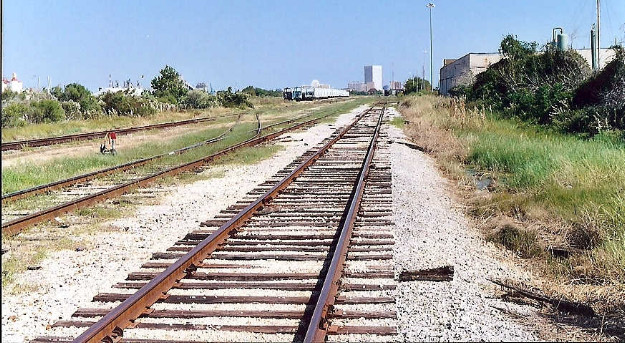
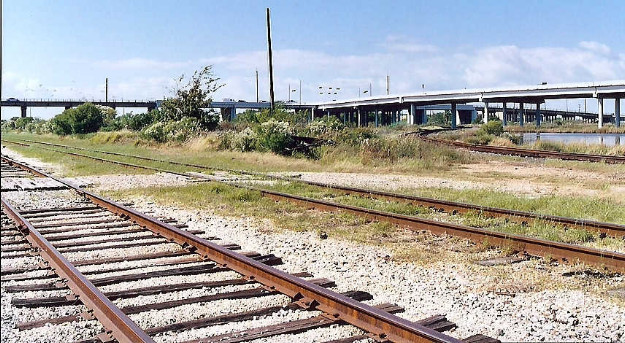
Don Harper comments on these
photos he took in November, 2006... Above Left: "Looking east, ground level, the
inbound UP (ex-GH&H)
lead is to the right and the
outbound lead is in the middle. At far left is the lead
to the Z-track that connects to the former SP (GH&SA)
yard. The crossover from
the Z-track to the outbound
UP lead can be seen. This is the same crossover that
is seen in the 1921 photo (top of page)."
Above Right: Don continues: "Looking northwest, ground
level, the UP inbound lead is to the left, the outbound lead is in the middle,
and the Z track curves away to the right. In the background are the 51st Street
overpass running left to right, and the elevated portion of Harborside Drive. Tower 38 was located very close
to
the power pole in the middle of the photo."
Below Left: Don
explains...
"Looking southeast from the Harborside Drive overpass, the Z
track curves
away from the UP leads heading toward the former
SP yard. Tower 38
stood close to the power pole
in the upper center of the photo surrounded by a clump of
vegetation." Below Right:
"Looking east from the 51st Street overpass, the UP (ex-GH&H) leads come
straight from the UP yard toward the causeway bridge (which
is about 2.7 miles behind Don.) The Z track can be seen curving off to
the left toward the former SP yard. Tower 38 stood near the shorter power pole
(surrounded by vegetation). The switch diverging from the inbound lead toward
the right serves cotton warehouses. At one time (see the 1921 photo at top of
page), a track diverged from the Z track, crossed both GH&H mains, and continued
to the warehouses -- the switch in this photo was not present in 1921. The ties
from this track are still in place on the south side of the UP leads."
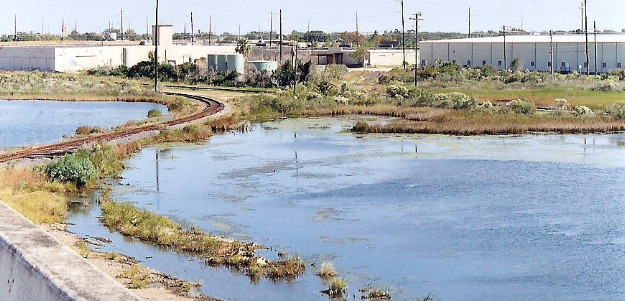
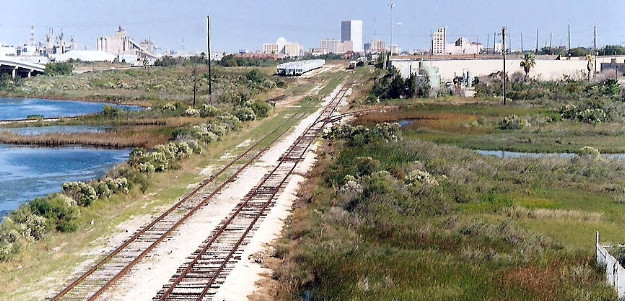
Right:
This Bird's Eye View from Bing Maps is oriented with North up. Downtown
is east, to the right and the causeway landing is about three miles west
(left). The image is labeled with the heritage railroads. Former tracks
of the GH&SA and GH&H are now owned by UP while BNSF owns the former
GC&SF tracks.
The location of Tower 38 is marked by the blue rectangle.
According to SP historian David Bernstein, the Tower 38 interlocker was
replaced by two automatic interlockers in 1960. (below,
Railway Signaling & Communications,
January, 1959)
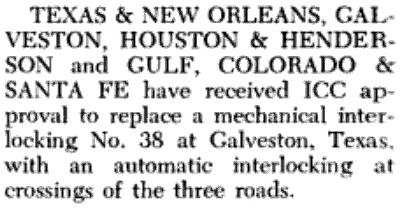
Interlocker 38A controlled the Z-track crossing of the Santa Fe tracks
and was retired in 1969. Interlocker 38B controlled the Z-track crossing
of the GH&H tracks and was retired in 1983.
Note the UP maintenance truck driving on the Z-Track (orange arrow) and the
eastbound BNSF locomotive (green arrow.)
|
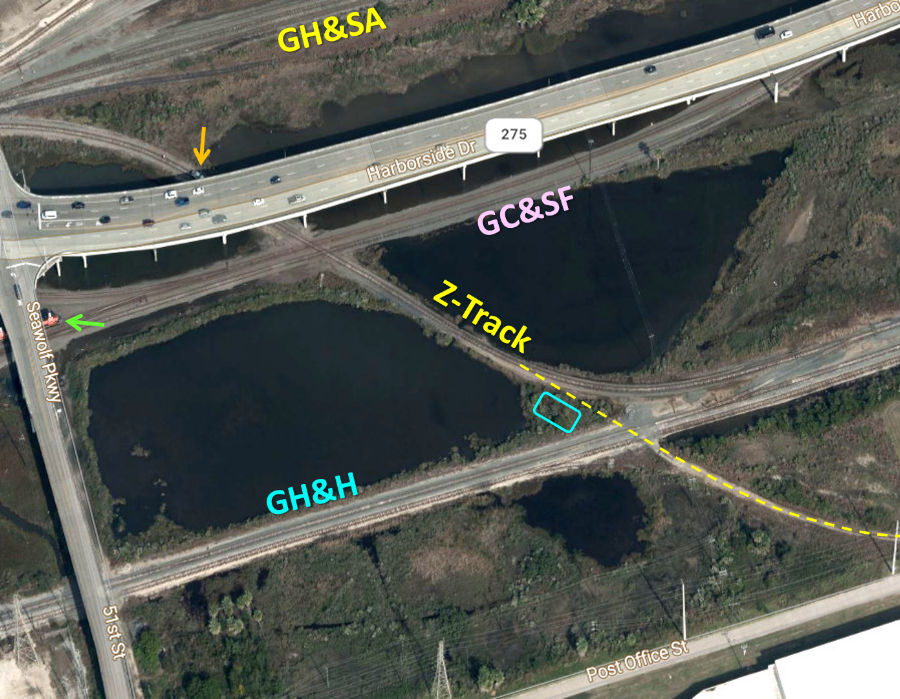 |


















